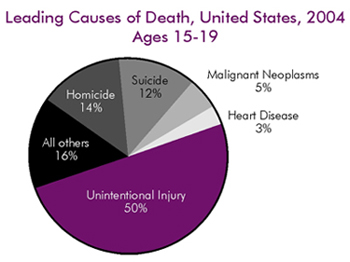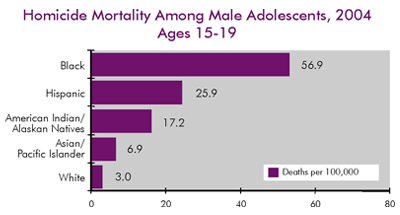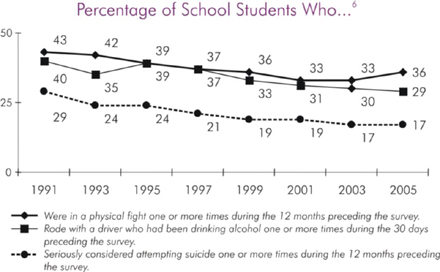



 |

|

Health Topics
Injury & Violence (including suicide)
School Health Guidelines
Summary
Injuries are the leading cause of death and disability for people aged
1 to 45 years in the United States.1 Moreover, between 10% and
25% of child and adolescent injuries occur on school premises.2
Because injuries take such a toll on the health and well-being of young
people, the Year 2010 National Health Objectives encourage schools to
provide comprehensive health education to prevent unintentional injuries,
violence, and suicide. More than 53 million young people attend over
119,000 schools every day. Including students and adults, one fifth of the
United States population can be found in schools.3 Therefore,
school-based programs can efficiently reach most of the nation’s children
and adolescents, as well as many adults.
Benefits of Preventing Unintentional Injuries and Violence in Schools
- All students have the right to learn in a safe and protective
school environment. Preventing unintentional injuries, violence, and
suicide in schools would help improve the learning environment.
- Preventing unintentional injuries, violence, and suicide in schools
could have a broader impact on community-wide efforts to promote
safety. Schools can teach students the skills needed to promote safety
and reduce their risk for unintentional injuries, violence, and suicide
throughout their lives.
Unintentional Injuries and Violence among Young People
Injuries kill more adolescents than all diseases combined. In 2003,
13,737 adolescents aged 15 to 19 years died from injuries.4 This equals
about 39 injury related deaths among adolescents per day — the population
of nearly two high school classrooms.


Unintentional Injury and Violence Among Minority Youth
- The United States child homicide rate, 2.6 per 100,000 for children
less than 15 years of age, is five times greater than the combined rate
of 25 other industrialized countries.5
- Among U.S. adolescents, minority males bear most of the burden of
homicide victimization.4
- In 2004, among adolescent males ages 15–19, the homicide rate for blacks is
more than twice that for Hispanics; 4 times that for American
Indian/Alaskan Natives; 8 times that for Asian/Pacific Islanders; and
almost 18 times that for whites.4
Trends in Unintentional Injury and Violence Among Youth
- From 2003 through 2007, the percentage of high school students who were involved
in a fight and the percentage who did not go to school because they felt unsafe at school
or on their way to or from school increased significantly. However, from 1991 through
2007 the percentage who rarely or never wore a seat belt, rode with a driver who
had been drinking alcohol, and seriously considered attempting
suicide decreased significantly.6

The above chart is available in text format.
CDC Guidelines for School Health Programs
CDC’s School Health Guidelines to Prevent Unintentional Injuries and
Violence were designed to help state and local education agencies and
schools promote safety and help schools be safe places for students to
learn. These guidelines were developed in collaboration with experts from
universities and national organizations and with federal, state, local,
and voluntary agencies. They are based on an extensive review of research,
theory, and current practice in unintentional injury, violence, and
suicide prevention; health education; and public health.
Key Principles
Unintentional injury, violence, and suicide prevention programs for
young people are most likely to be effective when they
- Become a national priority and are reinforced by community-wide
efforts in which school and community leaders, as well as families,
commit to implementing and sustaining unintentional injury, violence,
and suicide prevention.
- Are part of a coordinated school health program through which school
personnel, students, families, community organizations and agencies, and
businesses can collaborate to develop, implement, and evaluate injury
prevention efforts.
Recommendations
The guidelines consist of eight recommendations, for schools from
pre-kindergarten through the 12th grade, that help prevent injuries that
occur on school property and elsewhere. Every recommendation is not
appropriate or feasible for every school to implement. Schools should
prioritize the recommendations on the basis of their needs and available
resources.
- Social Environment
Establish a social environment that promotes safety and prevents
unintentional injury, violence, and suicide.
- Ensure high academic standards.
- Encourage students’ connectedness to school.
- Designate a school safety coordinator.
- Establish a supportive climate that does not tolerate harassment or
bullying.
- Develop, implement, and enforce written policies, including
disciplinary policies.
- Infuse prevention strategies into multiple school activities and
classes.
- Assess programs and policies at regular intervals.
- Physical Environment
Provide a physical environment, inside
and outside school buildings, that promotes safety and prevents
unintentional injuries and violence.
- Conduct regular safety and hazard assessments.
- Maintain structures, equipment, and grounds.
- Actively supervise all student activities.
- Ensure that the school environment is weapon-free.
- Health Education
Implement health and safety education curricula and instruction that
help students develop the knowledge, attitudes, behavioral skills, and
confidence needed to adopt and maintain safe lifestyles and to advocate
for health and safety.
- Choose programs and curricula that are grounded in theory or have
evidence of effectiveness.
- Implement prevention curricula consistent with national and state
standards for health education.
- Encourage student involvement in the learning process.
- Provide adequate staffing and resources.
- Physical Education and Physical Activity Programs
Provide safe physical education and extracurricular physical activity
programs.
- Develop, teach, implement, and enforce safety rules.
- Promote unintentional injury prevention and nonviolence through
physical education and sports participation.
- Ensure that spaces and facilities meet or exceed recommended
safety standards.
- Hire physical education and activity staff trained in injury
prevention, first aid, and CPR, and provide ongoing staff development.
- Health Services
Provide health, counseling, psychological, and social services to meet
students’ physical, mental, emotional, and social health needs.
- Coordinate school-based services.
- Establish strong links with community resources.
- Identify and provide assistance to students in need.
- Assess the extent to which injuries occur on school property.
- Develop and implement emergency plans.
- Crisis Response
Establish mechanisms for short- and long-term responses to crises, disasters, and injuries that affect the
school community.
- Establish a written response plan.
- Have short- and long-term responses and services in place after a
crisis.
- Family and Community Involvement
Integrate school, family, and community efforts to prevent unintentional
injuries, violence, and suicide.
- Involve family members in all aspects of school life.
- Educate and involve family members in prevention strategies.
- Coordinate school and community services.
- Staff Development
For all school personnel, provide regular staff development
opportunities that impart the knowledge, skills, and confidence to
effectively promote safety and prevent unintentional injuries, violence,
and suicide and support students in their efforts to do the same.
- Ensure that staff are knowledgeable and skillful about
unintentional injury, violence, and suicide prevention.
- Train all personnel to be positive role models for a healthful and
safe lifestyle and support them in their efforts.
References
-
Minino AM, anderson RN, Fingerhut LA, Boudreault MA,
Warner M. Deaths: Injuries, 2002. National Vital
Statistics Reports; vol 54, no 10. Hyattsville, Maryland;
National Center for Health Statistics 2006.
-
Danesco ER, Miller TR, Spicer RS. Incidence and costs
of 1987–1994 childhood injuries: demographic breakdowns. Pediatrics
2000;105(2).
-
U.S. Department of Education, National Center for
Education Statistics. Digest of education statistics, 1999. Washington,
DC: National Center for Education Statistics, 2000; publication no. (NCES)
2000–031.
-
CDC, National Center for Injury Prevention and
Control, Office of Statistics and Programming. Web-based Injury
Statistics Query and Reporting System (WISQARS). Online at
http://www.cdc.gov/ncipc/wisqars/. Accessed October 8, 2008.
-
CDC. Rates of homicide, suicide and firearm-related
deaths among children—26 industrialized countries. Morbidity &
Mortality Weekly Report 1997;46:101–5.
-
CDC. Youth Risk Behavior Surveillance—United States, 2007.
Morbidity & Mortality Weekly Report 2006;55(SS-5):1–112.
Back to Top
Documents on this page are available in
Portable Document Format (PDF). Learn more about viewing and printing
these documents with Acrobat
Reader.
|

|



